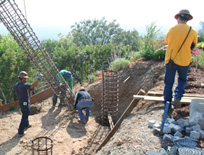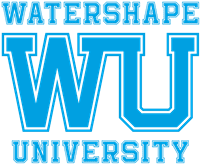Pools & Spas
Through the past several years, I've witnessed a debate among people in the watershaping industry about whether every construction project should require soils and geology reports as part of every design and engineering process. Most of my colleagues who work in the custom, quality-oriented end of the business will
For decades, controversy has surrounded the initial interactions of water and cementitious finishes in pools and spas – controversy that has led to heated debate, bad blood, litigation and very little by way of resolution. But that hasn’t stopped numerous organizations and individuals from working toward an answer, says Randy Dukes, who discusses here an
One of the great things about watershaping is how the work can lead you to unexpected places where you sometimes encounter vastly different ways of doing things. In the past few years, for instance, my design work has led me to design a number of projects in the great open spaces of western Canada – many of which have been built by Gene Brown of Valley Pools in Kelowna, British Columbia. Working with this true professional has taught me a great deal about the precision and power that comes in using poured-in-place concrete as a medium and, as a result, has greatly influenced my thinking about how watershapers everywhere should strive to elevate their own standards of construction. My northward migration began with small steps. In fact, I started off with Valley Pools simply as a consultant for hydraulic and mechanical issues, exchanging plans with Brown and helping him ensure the functionality of some of the more complex systems he found himself doing. At first, I did little more than flesh out the plans mechanically, but I couldn’t help noticing that he was finding some interesting projects – and also observed that he was one of those watershapers who had completely dedicated himself to excellence in all facets of the work. Our usual exchanges were set aside, however, when one day he sent me a set of plans that had been produced by an architect in collaboration with
It seems like ages ago, those glowing days when a spa – whether separate from or connected somehow to a swimming pool – stood on the absolute cutting edge of residential watershaping. These days, by contrast, systems designed to deliver hot water and hydrotherapy to our clients have become so familiar that they’re almost taken for granted. From what I’ve heard, it’s almost reached the point where discussions leading up to some of the best custom projects are treating spas as
With watershapes, sometimes the most straightforward forms work out best. That was definitely the case with this project, a swimming pool I designed and built for a beach club near my home in Guanacaste, Costa Rica. The club is part of an overall resort property known as Reserva Conchal, an utterly spectacular spread covering 2,500 acres on scenic Playa Conchal on our country’s north Pacific coast. I first became involved with the resort’s owners about ten years ago, when they were completing their first phase and I helped them solve some problems with a pool that had been built by another firm. Since then, as the owners’ master plan has gradually unfolded, I’ve worked with them on a number of pools in various spots around the huge property, including watershapes for various condominiums and other facilities. My involvement with their newly constructed club has been, by far, the most
Places just below the earth’s surface have been a resource for heating and cooling basically since the planet took shape. Ever since, all sorts of creatures have taken refuge from excessive heat or extreme cold by burrowing into the soil, and it’s no accident that some of the earliest examples of human self-expression have been found in caves deep below the surface. With pools and spas, however, up until recently there’s always been a legitimate question about whether this timeless heating/cooling approach was workable on any sort of cost-effective basis. If recent projects designed by my firm, Aloha Pools Design Studio (Franklin, Tenn.) are any indication, that question has now been answered with a resounding yes. On the face of it, that answer seems obvious. After all, the U.S. Department of Energy says that geothermal heating is more cost effective than a 95-percent efficient gas heater – and that the same would be true even if 100-percent efficient gas heaters were available. Only recently, however, have the suppliers of these systems reached a point where their equipment is
Swimming pools don’t always need to be complex or innovative to be beautiful. In fact, I’d like to suggest that even the simplest of design programs, when handled well by the watershaper, can lead to outstanding results. The reasons are obvious and well known: With water, we manage the world’s most beautiful and alluring design material. If we do a good job, put that water in the right place and build our structures well, the potential for achieving gorgeous results is almost always within reach and we organize reflections, flows, sounds, hardscape and plants. If all of those elements are in control and integrated into the same thoughtful program, in other words, even the most basic of projects can be so aesthetically on target that it will elicit strong emotional responses. All of these factors were in play with the small pool discussed here: With just 800 square feet of surface area, it sits in the front yard of a modest but attractive home in the Five Towns area of New York’s Long Island and is distinguished by
As a rule, I avoid working for contractors: I’ve found that far too many of them spend so much time worrying about the bottom line that they lose sight of the fact that their clients want quality rather than compromises. I’ve also found that their general caution is often at its worst when it comes to watershapes: Even though these structures may be key components of the overall project, they tend to come along late in the process and are all too often seen as places where corners can be cut to meet overall budget goals. Frankly, I’ve never liked being treated as a pawn or second-class citizen, so I avoid these situations like the plague. Instead, I typically work directly for homeowners and refuse to subordinate my part of a project to the whims of another contractor. Any worthwhile rule, however, has
Automatic swimming pool covers are wonderful in a number of ways: They increase safety, save energy, limit evaporative water losses, keep debris out of a pool and can even reduce chemical consumption. As a watershaper, I want these devices to be trouble-free so they will perform with nothing more than routine maintenance and my clients can
In his book Gardening with Water, James van Sweden called water “the heart of the garden.” I’ve had the privilege of working with him and his partner, Wolfgang Oehme, since 1986, and all of us at Oehme, van Sweden & Associates (Washington, D.C.) share an appreciation for the simple profundity of our founding partner’s words that is clearly reflected in the way we use water. To be sure, we occasionally design gardens without water, but more often it’s a key part of what we do and serves as a powerful foil to plants, hardscape, art and architecture. We enthusiastically take advantage of the way it brings contrasts, reflections and sounds to spaces and exploit its ability to define destinations, invite recreation or provide gathering spaces. We also work closely with all of the psychological associations it conjures within human beings – feelings of tranquility or excitement as well as sensations of the raw, regenerative power of nature. In our work, which spans the full spectrum of residential, commercial, public and institutional settings, fully 80 percent include watershapes in some form, from lily ponds, rills or cascades to formal fountains or swimming pools. Occasionally these are stand-alone features, but when the situation permits, we’ll use them in






















